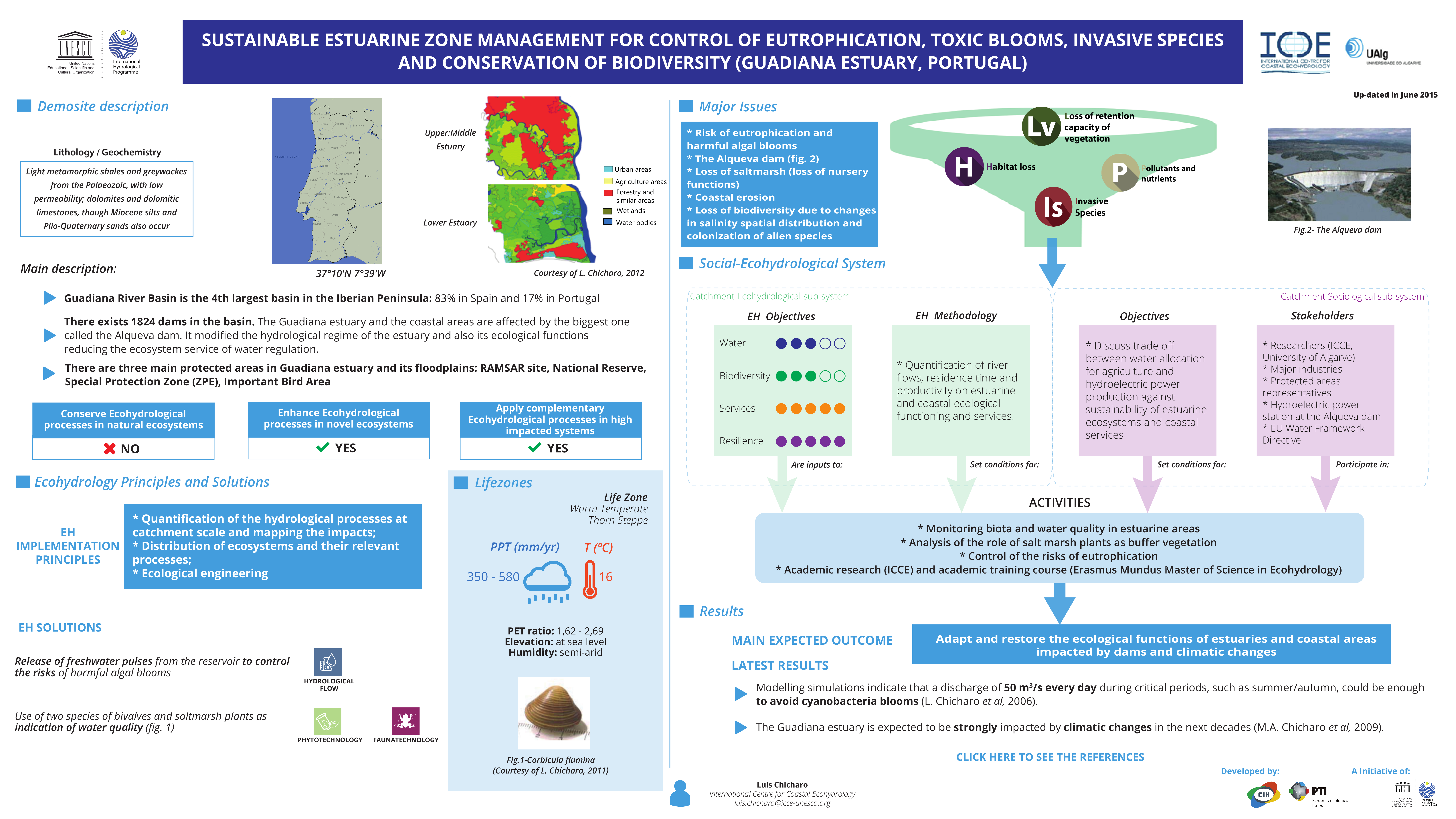SUSTAINABLE ESTUARINE ZONE MANAGEMENT FOR CONTROL OF EUTROPHICATION, TOXIC BLOOMS, INVASIVE SPECIES AND CONSERVATION OF BIODIVERSITY (GUADIANA ESTUARY, PORTUGAL)


Description
Location


Sketch

Information about lithology/geochemistry:
Light metamorphic shales and greywackes from the Palaeozoic, with low permeability; dolomites and dolomitic limestones, though Miocene silts and Plio-Quaternary sands also occur
Main Description
- Guadiana River Basin is the 4th largest basin in the Iberian Peninsula: 83% in Spain and 17% in Portugal.
- There exists 1824 dams in the basin. The Guadiana estuary and the coastal areas are affected by the biggest one called the Alqueva dam. It modified the hydrological regime of the estuary and also its ecological functions reducing the ecosystem service of water regulation.
- There are three main protected areas in Guadiana estuary and its floodplains: RAMSAR site, National Reserve, Special Protection Zone (ZPE), Important Bird Area.
Enhance ecohydrological processes in novel ecosystem
YES
Apply complementary Ecohydrological processes in high impacted system
YES
This table presents the different categories of ecosystem services that ecosystem can provide, divided in:
Provisioning Services are ecosystem services that describe the material or energy outputs from ecosystems. They include food, water and other resources.

Food: Ecosystems provide the conditions for growing food. Food comes principally from managed agro-ecosystems but marine and freshwater systems or forests also provide food for human consumption. Wild foods from forests are often underestimated.
Regulating Services are the services that ecosystems provide by acting as regulators eg. regulating the quality of air and soil or by providing flood and disease control.

Moderation of extreme events: Extreme weather events or natural hazards include floods, storms, tsunamis, avalanches and landslides. Ecosystems and living organisms create buffers against natural disasters, thereby preventing possible damage. For example, wetlands can soak up flood water whilst trees can stabilize slopes. Coral reefs and mangroves help protect coastlines from storm damage.
Ecosystem services "that are necessary for the production of all other ecosystem services". These include services such as nutrient recycling, primary production and soil formation.

Habitats for species: Habitats provide everything that an individual plant or animal needs to survive: food; water; and shelter. Each ecosystem provides different habitats that can be essential for a species’ lifecycle. Migratory species including birds, fish, mammals and insects all depend upon different ecosystems during their movements.

Maintenance of genetic diversity: Genetic diversity is the variety of genes between and within species populations. Genetic diversity distinguishes different breeds or races from each other thus providing the basis for locally well-adapted cultivars and a gene pool for further developing commercial crops and livestock. Some habitats have an exceptionally high number of species which makes them more genetically diverse than others and are known as ‘biodiversity hotspots’.
Cultural Services corresponds nonmaterial benefits people obtain from ecosystems through spiritual enrichment, cognitive development, reflection, recreation, and aesthetic experiences.
Lifezones

![]()
PPT(mm/yr): 465.0
![]()
T(ºc): 16.0
| Elevation of demosite: | 0.0 meters above sea level |
| Humidity: | Semi-Arid |
| PETr (by year): | 2.15 |
EH Principles
Quantification of the hydrological processes at catchment scale and mapping the impacts
Distribution of ecosystems and their relevant processes (ex: metabolism=water and nutrient uptake and retention; biomass production)
Ecological engineering (integration, dual regulation and biotechnologies in catchment scale for enhancement of ecological potential)
ECOHYDROLOGY ENGINEERING SOLUTIONS
Use of two species of bivalves and saltmarsh plants as indication of water quality (fig. 1).
 Faunatechnology
Faunatechnology
 Phytotechnology
Phytotechnology
Release of freshwater pulses from the reservoir to control the risks of harmful algal blooms.
 Hydrological Flow
Hydrological Flow
Major Issues
- Risk of eutrophication and harmful algal blooms
- The Alqueva dam
- Loss of saltmarsh (loss of nursery functions)
- Coastal erosion
- Loss of biodiversity due to changes in salinity spatial distribution and colonization of alien species






Expected Outcomes
Adapt and restore the ecological functions of estuaries and coastal areas impacted by dams and climatic changes.
Latest Results
- Modelling simulations indicate that a discharge of 50 m³/s every day during critical periods, such as summer/autumn, could be enough to avoid cyanobacteria blooms (L. Chicharo et al, 2006).
- The Guadiana estuary is expected to be strongly impacted by climatic changes in the next decades (M.A. Chicharo et al, 2009).
Contacts
Luis Chicharo
- luis.chicharo@icce-unesco.org
- International Centre for Coastal Ecohydrology

Social ecohydrological system
EH Objectives
EH Methodology
Catchment Ecohydrological sub-system
Objectives
Stakeholders
Catchment Sociological sub-system
Activities